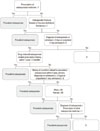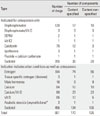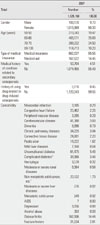1. World Health Organization. WHO Technical Report Series, 843. 1994.
2. Korean National Health and Nutrition Examination Survey in 2008 results presentation. Korea Centers for Disease Control and Prevention;Available at:
http://knhanes.cdc.go.kr.
3. Lim S, Koo BK, Lee EJ, Park JH, Kim MH, Shin KH, Ha YC, Cho NH, Shin CS. Incidence of hip fractures in Korea. J Bone Miner Metab. 2008. 26:400–405.
4. Shin CS, Jo NH, Kim Y, Kim SW, Park JH, Kim MH, Kim IK. Study of an osteoporosis management program in Korea. 2007. Seoul National University;Unpublished manuscript.
5. Rowe SM, Yoon TR, Ryang DH. An epidemiological study of hip fracture in Honam, Korea. Int Orthop. 1993. 17:139–143.
6. Kim NS. The effect of adherence to antidepressant treatment on relapse and recurrence of depression. 2008. Graduate school of Public Health, Seoul National University;Ph.D. Dissertation.
7. Kim JY, Kim HY, Im JH. Development of risk adjustment and prediction methods for care episodes using National Health Insurance Database. 2007. Seoul: Health Insurance Review & Assessment Service.
8. Westfall G, Littlefield R, Heaton A, Martin S. Methodology for identifying patients at high risk for osteoporotic fracture. Clin Ther. 2001. 23:1570–1588.
9. Ray WA, Griffin MR, Fought RL, Adams ML. Identification of fractures from computerized Medicare files. J Clin Epidemiol. 1992. 45:703–714.
10. Park BJ, Sung JH, Park KD, Seo SW, Kim SH. Improving the validity of health insurance disease code and the utilization of health insurance claim data. 2003. Seoul National University College of Medicine · Health Insurance Review & Assessment Service.
11. Sokol MC, McGuigan KA, Verbrugge RR, Epstein RS. Impact of medication adherence on hospitalization risk and healthcare cost. Med Care. 2005. 43:521–530.
12. The Korean Society of Bone Metabolism. Physician's Guide for Diagnosis & Treatment of Osteoporosis. 2008.
14. Clinician's guide to prevention and treatment of osteoporosis. 2008. USA: National osteoporosis foundation.
15. The Japanese Society for Bone and Mineral Research. 骨粗鬆症の予防と治療ガイドライン. 2006.
16. Kanis JA, Burlet N, Cooper C, Delmas PD, Reginster JY, Borgstrom F, Rizzoli R. European Society for Clinical and Economic Aspects of Osteoporosis and Osteoarthritis (ESCEO). European guidance for the diagnosis and management of osteoporosis in postmenopausal women. Osteoporos Int. 2008. 19:399–428.
17. National Institute for Health and Clinical Excellence, Alendronate, etidronate, risedronate, raloxifene and strontium ranelate for the primary prevention of osteoporotic fragility fractures in postmenopausal women. 2008. 10.
18. Sambrook PN, Seeman E, Phillips SR, Ebeling PR. Osteoporosis Australia. National Prescribing Service: Preventing osteoporosis. outcomes of the Australian Fracture Prevention Summit. Med J Aust. 2002. 176:S1–S16.
19. Charlson ME, Pompei P, Ales KL, MacKenzie CR. A new method of classifying prognostic comorbidity in longitudinal studies: development and validation. J Chronic Dis. 1987. 40:373–383.
20. Kim KH. Review of comorbidities adjustment methodology using administrative claims data. HIRA Policy Trend. 2008. 2:58–62.
21. Sundararajan V, Quan H, Halfon P, Fushimi K, Luthi JC, Burnand B, Ghali WA. Cross-national comparative performance of three versions of the ICD-10 Charlson index. Med Care. 2007. 45:1210–1215.
22. Jang SM, Song HJ, Sheen SY, Sung YN, Kim SO, Kim CS. Development of assessment indicators of antihypertensive drugs. 2008. Health Insurance Review & Assessment Service.
23. Korean Diabetes Association. Health Insurance Review & Assessment Service, Diabetes in Korea. 2007.
24. Ministry for Health, Welfare and Family Affairs, Korean National Health and Nutrition Examination Survey in 2005. Korea Center for Disease Control & Prevention. Available at:
http://knhanes.cdc.go.kr.
25. Kanis JA, Johnell O, Oden A, Borgstrom F, Johansson H, De Laet C, Jonsson B. Intervention thresholds for osteoporosis in men and women: a study based on data from Sweden. Osteoporos Int. 2005. 16:6–14.





 PDF
PDF ePub
ePub Citation
Citation Print
Print


















 XML Download
XML Download